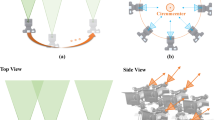Abstract
Multispectral photometric stereo (MPS) aims at recovering the surface normal of a scene measured under multiple light sources with different wavelengths. While it opens up a capability of a single-shot measurement of surface normal, the problem has been known ill-posed. To make the problem well-posed, existing MPS methods rely on restrictive assumptions, such as shape prior, surfaces having a monochromatic with uniform albedo. This paper alleviates these restrictive assumptions in existing methods. We show that the problem becomes well-posed for surfaces with uniform chromaticity but spatially-varying albedos based on our new formulation. Specifically, if at least three (or two) scene points share the same chromaticity, the proposed method uniquely recovers their surface normals with the illumination of no less than four (or five) spectral lights in a closed-form. In addition, we show that a more general setting of spatially-varying both chromaticities and albedos can become well-posed if the light spectra and camera spectral sensitivity are calibrated. For this general setting, we derive a unique and closed-form solution for MPS using the linear bases extracted from a spectral reflectance database. Experiments on both synthetic and real captured data with spatially-varying reflectance demonstrate the effectiveness of our method and show the potential applicability for multispectral heritage preservation.












Similar content being viewed by others
Notes
When RGB images are used in conventional (single-band) photometric stereo, they are turned into grayscale images for computing surface normal.
https://www.imec-int.com/en. Retrieved Mar. 11, 2021.
Please refer to the supplementary video.
References
Anderson, R., Stenger, B., & Cipolla, R. (2011a). Augmenting depth camera output using photometric stereo. In Proceedings of IAPR conference on machine vision and applications (MVA) (pp. 369–372).
Anderson, R., Stenger, B., & Cipolla, R. (2011b). Color photometric stereo for multicolored surfaces. In Proceedings of international conference on computer vision (ICCV) (pp. 2182–2189).
Antensteiner, D., Stolc, S., & Soukup, D. (2019). Single image multi-spectral photometric stereo using a split U-Shaped CNN. In Proceedings of IEEE conference on computer vision and pattern recognition workshops (CVPRW) (pp. 481–483).
Barsky, S., & Petrou, M. (2003). The 4-source photometric stereo technique for three-dimensional surfaces in the presence of highlights and shadows. IEEE Transactions on Pattern Analysis and Machine Intelligence, 25, 1239–1252.
Chakrabarti, A., & Sunkavalli, K. (2016). Single-image rgb photometric stereo with spatially-varying albedo. In International conference on 3D vision (3DV) (pp. 258–266).
Cho, D., Matsushita, Y., Tai, Y. W., & Kweon, I. S. (2018). Semi-calibrated photometric stereo. IEEE Transactions on Pattern Analysis and Machine Intelligence, 42, 232–245.
Cox, M. A., & Cox, T. F. (2008). Multidimensional scaling. In Handbook of data visualization (pp. 315–347).
Drew, M. S., & Kontsevich, L. L. (1994). Closed-form attitude determination under spectrally varying illumination. In Proceedings of IEEE conference on computer vision and pattern recognition (CVPR) (pp. 985–990).
Dupuy, J., & Jakob, W. (2018). An adaptive parameterization for efficient material acquisition and rendering. ACM Transactions on Graphics, 37, 1–14.
Fyffe, G., Yu, X., & Debevec, P. (2011). Single-shot photometric stereo by spectral multiplexing. In Proceedings of IEEE international conference on computatiosnal photography (ICCP) (pp. 1–6).
Guo, H., Okura, F., Shi, B., Funatomi, T., Mukaigawa, Y., & Matsushita, Y. (2021). Multispectral photometric stereo for spatially-varying spectral reflectances: A well posed problem? In Proceedings of IEEE conference on computer vision and pattern recognition (CVPR).
Hain, M., Bartl, J., & Jacko, V. (2003). Multispectral analysis of cultural heritage artefacts. Measurement Science Review, 3, 9–12.
Hernández, C., Vogiatzis, G., Brostow, G.J., Stenger, B., & Cipolla, R. (2007). Non-rigid photometric stereo with colored lights. In Proceedings of IEEE conference on computer vision and pattern recognition (CVPR) (pp. 1–8).
Hernández, C., Vogiatzis, G., & Cipolla, R. (2010). Overcoming shadows in 3-source photometric stereo. IEEE Transactions on Pattern Analysis and Machine Intelligence, 33, 419–426.
Johnson, R. M. (1963). On a theorem stated by eckart and young. Psychometrika, 28(3), 259–263.
Ju, Y., Dong, X., Wang, Y., Qi, L., & Dong, J. (2020). A dual-cue network for multispectral photometric stereo. Pattern Recognition, 100, 107162.
Ju, Y., Qi, L., He, J., Dong, X., Gao, F., & Dong, J. (2020). MPS-Net: Learning to recover surface normal for multispectral photometric stereo. Neurocomputing, 375, 62–70.
Ju, Y., Qi, L., Zhou, H., Dong, J., & Lu, L. (2018). Demultiplexing colored images for multispectral photometric stereo via deep neural networks. IEEE Access, 6, 30804–30818.
Kontsevich, L., Petrov, A., & Vergelskaya, I. (1994). Reconstruction of shape from shading in color images. Journal of the Optical Society of America, 11, 1047–1052.
Matusik, W. (2003). A data-driven reflectance model. Ph.D. thesis, Massachusetts Institute of Technology
McCamy, C. S., Marcus, H., Davidson, J. G., et al. (1976). A color-rendition chart. Journal of Application Photography and Engineering, 2(3), 95–99.
Miyazaki, D., Hara, K., & Ikeuchi, K. (2010). Median photometric stereo as applied to the segonko tumulus and museum objects. International Journal of Computer Vision, 86, 229.
Miyazaki, D., Onishi, Y., & Hiura, S. (2019). Color photometric stereo using multi-band camera constrained by median filter and occluding boundary. Journal of Imaging, 5, 64.
Mohammadi, M., Nezamabadi, M., & Berns, R. (2005). A prototype calibration target for spectral imaging. Association Internationale de la Couleur (AIC)-International Color Association.
Ozawa, K., Sato, I., & Yamaguchi, M. (2018). Single color image photometric stereo for multi-colored surfaces. Computer Vision and Image Understanding, 171, 140–149.
Picollo, M., Cucci, C., Casini, A., & Stefani, L. (2020). Hyper-spectral imaging technique in the cultural heritage field: New possible scenarios. Sensors, 20(10), 2843.
Shi, B., Tan, P., Matsushita, Y., & Ikeuchi, K. (2014). Bi-polynomial modeling of low-frequency reflectances. IEEE Transactions on Pattern Analysis and Machine Intelligence, 36, 1078–1091.
Shi, B., Wu, Z., Mo, Z., Duan, D., Yeung, S.K., & Tan, P. (2019). A benchmark dataset and evaluation for non-lambertian and uncalibrated photometric stereo. IEEE Transactions on Pattern Analysis and Machine Intelligence, 271–284.
Silver, W. M. (1980). Determining shape and reflectance using multiple images. Master’s thesis, MIT.
Vogiatzis, G., & Hernández, C. (2012). Self-calibrated, multi-spectral photometric stereo for 3d face capture. International Journal of Computer Vision, 97, 91–103.
William, H., Teukolsky, S. A., Saul, A., Vetterling, W. T., & Flannery, B.P. (2007). Numerical recipes: The art of scientific computing.
Woodham, R. (1980). Photometric method for determining surface orientation from multiple images. Optical Engineering, 19, 139–144.
Wu, L., Ganesh, A., Shi, B., Matsushita, Y., Wang, Y., & Ma, Y. (2010). Robust photometric stereo via low-rank matrix completion and recovery. In Proceedings of asian conference on computer vision (ACCV) (pp. 703–717). Springer.
Xie, W., Zhang, Y., Wang, C. C., & Chung, R. C. K. (2014). Surface-from-gradients: An approach based on discrete geometry processing. In Proceedings of IEEE conference on computer vision and pattern recognition (CVPR) (pp. 2195–2202).
Zhang, Z. (2000). A flexible new technique for camera calibration. IEEE Transactions on Pattern Analysis and Machine Intelligence, 22, 1330–1334.
Acknowledgements
This work was supported by Japan Science and Technology Agency CREST Grant Number JPMJCR1764, and National Natural Science Foundation of China under Grant Number 62136001, 62088102, and 61872012.
Author information
Authors and Affiliations
Corresponding author
Additional information
Communicated by Katsushi Ikeuchi.
Publisher's Note
Springer Nature remains neutral with regard to jurisdictional claims in published maps and institutional affiliations.
Appendix: Limitation of 3-Band Multispectral Photometric Stereo Methods
Appendix: Limitation of 3-Band Multispectral Photometric Stereo Methods
As described in Sec. 2, existing methods Ozawa et al. (2018); Chakrabarti and Sunkavalli (2016) provide a unique solution for the monochromatic surface with a uniform albedo (SRT II) using 3-channel RGB images. These methods are limited to 3 channels, and it is not straightforward to extend them to take more channels as input. However, the capability of taking more channels is favorable because it allows us to use robust estimation techniques, effectively neglecting outliers such as shadows and specular reflections. Here we show the reason why the existing methods are limited to 3-channel input.
Without loss of generality, we fix the common albedo \({\tilde{\rho }}\) for all the scene points on SRT II surface to be 1 and define a diagonal matrix \(\mathbf {Q}\) as \(\mathbf {Q} = \mathrm{diag}(\mathbf {q})\). Following Eq. (4), the image observation for a pixel can be represented as
Defining Moore-Penrose inverse matrix \(\mathbf {K} \in {\mathbb {R}}^{3 \times f}\) as \(\mathbf {K} = (\mathbf {QL})^{\dagger }\), the surface normal is then calculated by
The existing methods Ozawa et al. (2018); Chakrabarti and Sunkavalli (2016) use a unit norm constraint about a surface normal as
As shown in Eq. (25), by defining \(\mathbf {E} = \mathbf {K}^{\top } \mathbf {K} \in {\mathbb {R}}^{f \times f}\), each one of the p scene points provides an equation about \(\mathbf {E}\) as
Defining \(\mathbf {m} \otimes \mathbf {m} = \mathrm{vec}(\mathbf {m}\mathbf {m}^\top )\), we rewrite Eq. (25) in a matrix form,
where \(\otimes \) represents the Kronecker product, and \(\mathbf {H}\) forms a \(p \times f^2\) matrix. Since \(\mathbf {E} \in {\mathbb {R}}^{f \times f}\) is symmetric, \(\mathbf {y}\) only has at most \(\frac{f(f+1)}{2}\) distinct elements. We extract the elements of \(\mathbf {y}\) that correspond to the upper triangle elements from \(\mathbf {E}\) as \(\mathbf {z} \in {\mathbb {R}}^{\frac{f(f+1)}{2}}\) and the corresponding columns from \(\mathbf {H}\) as \(\hat{\mathbf {H}} \in {\mathbb {R}}^{p \times \frac{f(f+1)}{2}}\). Then we rewrite Eq. (26) as
The necessary condition to obtain a unique approximate solution for \(\mathbf {z}\) is \(\hat{\mathbf {H}}\) to have full-rank, i.e., assuming \(p \ge f(f+1)\),
On the other hand, since the image observations for all the scene points under Lambertian reflectance has the rank of 3, we can represent any irradiance measurements with three independent basis \(\{\mathbf {e}_1, \mathbf {e}_2, \mathbf {e}_3 \in {\mathbb {R}}^f\}\), i.e.,
With this expression, we can represent \(\mathbf {m} \otimes \mathbf {m}\) as
It indicates that \(\mathbf {m} \otimes \mathbf {m}\) can be represented by at most 6 independent f-dimensional basis vectors \(\mathbf {e}_i \otimes \mathbf {e}_j\). Since \(\mathbf {H}\) in Eq. (26) is a stack of \(\mathbf {m} \otimes \mathbf {m}\), the rank of \(\mathbf {H}\) should satisfy
Together with the necessary condition in Eq. (28) for solving Eq. (27), it leads to the following inequality,
which indicates that the number of spectral channels f of the input multispectral image should be no more than 3. Therefore, these existing method Ozawa et al. (2018); Chakrabarti and Sunkavalli (2016) cannot be adapted to multispectral images with more than three bands. On the other hand, our method is free from this restriction.
Rights and permissions
About this article
Cite this article
Guo, H., Okura, F., Shi, B. et al. Multispectral Photometric Stereo for Spatially-Varying Spectral Reflectances. Int J Comput Vis 130, 2166–2183 (2022). https://doi.org/10.1007/s11263-022-01634-4
Received:
Accepted:
Published:
Issue Date:
DOI: https://doi.org/10.1007/s11263-022-01634-4




